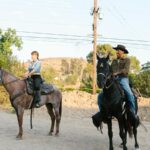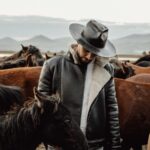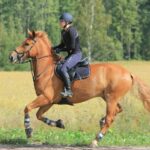In the vast landscapes of the American West, a set of unwritten principles has long guided the interactions between cowboys, their horses, and the land they steward. This “Cowboy Code” – a blend of honor, respect, hard work, and self-reliance – has profoundly shaped equine training methods and ranch life across generations. More than just practical guidelines for livestock management, these principles represent a cultural philosophy that values integrity in human-animal relationships and responsible land stewardship. From the earliest frontier days to modern ranching operations, these ideals have created distinctive approaches to horsemanship that balance firmness with fairness, while fostering a deep connection between rider and mount. This exploration reveals how these time-honored values continue to influence equine training methods and sustain the unique cultural identity of American ranch life.
The Origins of the Cowboy Code

The Cowboy Code emerged organically from the demanding conditions of the American frontier, where survival depended on character, skill, and mutual trust between a rider and horse. These principles weren’t initially written down but were passed through generations as a practical philosophy encompassing honesty, loyalty, respect for animals and land, and personal accountability. Early cowboys, drawing from diverse cultural backgrounds including Mexican vaquero traditions, Native American horsemanship, and European riding disciplines, created a uniquely American approach to working with livestock. As cattle drives and ranching expanded across the West in the late 19th century, these values solidified into an identifiable ethos that guided behavior and relationships. The code evolved as both a practical necessity for dangerous work and a moral framework that defined what it meant to be a responsible steward of animals and land.
Core Values of the Cowboy Code

At its heart, the Cowboy Code emphasizes honesty, integrity, and taking responsibility for one’s actions – values that directly translate to how horses are handled and trained. The principle that “a man’s word is his bond” extends to the consistency and fairness cowboys show their horses, establishing clear expectations and reliable communication. Self-reliance and hard work reflect in the patience required for proper training, where shortcuts are viewed as compromising quality and potentially endangering both horse and rider. Respect for animals as partners rather than mere tools stands as a cornerstone principle, acknowledging the intelligence and sensitivity of horses while maintaining appropriate boundaries. Perhaps most importantly, the code emphasizes courage tempered with humility – the willingness to face challenges while recognizing one’s limitations and learning from mistakes, creating a balanced approach to horsemanship that neither coddles nor brutalizes the animals.
Horse Training Through the Lens of Respect

Respect forms the foundation of cowboy-style horse training, creating a methodology where horses are viewed as thinking partners rather than subordinates to be dominated. This approach recognizes that effective training builds on the horse’s natural instincts and communication systems rather than forcing human expectations onto an animal with fundamentally different perception. Traditional cowboy trainers develop horses through progressive challenges that build confidence and understanding, always mindful that pushing too hard or fast violates both the animal’s trust and the trainer’s integrity. While maintaining clear leadership, genuine cowboy methods avoid breaking a horse’s spirit, instead channeling its natural energy and intelligence toward cooperative work. This respectful approach yields horses that willingly engage with riders rather than merely complying out of fear, creating safer, more reliable working partners capable of thinking through unpredictable situations.
Patience as a Training Virtue

The cowboy principle that “the best horse training happens on the slowest possible schedule” directly challenges modern society’s expectation for immediate results. Traditional ranch horse development often unfolds over years rather than weeks, with young horses given time to mature both physically and mentally before facing serious work demands. This patience manifests in training sessions that end on positive notes rather than pushing until exhaustion, recognizing that learning occurs during rest periods when horses process new information. Working cowboys understand that rushing creates gaps in a horse’s education that will inevitably require correction later, often at greater cost to both animal and handler. The patience-centered approach prevents many behavior problems that develop when horses are overwhelmed or confused, creating mounts that remain reliable even in high-pressure situations like separating cattle or navigating difficult terrain.
Consistency and Clear Communication

The Cowboy Code’s emphasis on honesty translates directly into training methods that prioritize consistent, clear signals between horse and rider. Traditional western horsemanship developed refinement despite its utilitarian origins, with subtle weight shifts, leg positions, and rein pressure forming a sophisticated communication system. Cowboy trainers focus on developing consistent cues that make sense to the horse’s natural way of processing information, rather than imposing arbitrary signals that confuse the animal. This straight-dealing approach extends to consistent expectations and boundaries, where horses learn exactly what behaviors earn release of pressure or reward. Ranch horses trained with this consistency develop remarkable reliability because they thoroughly understand what’s being asked, reducing the stress and resistance that come with confusion. This communication system, refined over generations of practical application, creates the seemingly effortless partnership observed in skilled ranch teams.
Fair Discipline Within Clear Boundaries

The cowboy approach to correction balances firmness with fairness, creating boundaries without resorting to fear or intimidation. Traditional methods employ the principle of “just enough pressure” – applying the minimum correction needed to communicate a boundary, then immediately releasing when the horse responds appropriately. This pressure-release system, when applied consistently, teaches horses to seek the right answer rather than anxiously guessing or shutting down mentally. Experienced ranch trainers carefully distinguish between a horse’s deliberate resistance and confusion or fear, adjusting their approach accordingly rather than escalating pressure inappropriately. The timing of correction proves as important as its intensity in cowboy training, with immediate feedback helping horses clearly connect their actions with consequences. This balanced discipline creates horses that respect handlers without fearing them, allowing the trust necessary for dangerous work situations.
Building Trust Through Progressive Challenges

Ranch horse training embodying the Cowboy Code follows a methodical progression that builds confidence through incrementally challenging experiences. Rather than throwing horses into overwhelming situations, traditional methods introduce new elements systematically – from basic groundwork to carrying weight, simple directional cues, and eventually complex tasks like cattle work. Each successfully navigated challenge becomes a trust deposit in the relationship between horse and handler, creating psychological security that helps horses face unfamiliar situations with composure. This progressive approach particularly shines in preparing horses for potentially frightening ranch work, from crossing streams to working around unpredictable livestock. Working cowboys recognize that recovering from a fear response requires significantly more time than preventing one, so they carefully manage exposure to build resilience. The resulting trust between horse and rider becomes the invisible foundation that makes the extraordinary ordinary in daily ranch work.
Self-Reliance in Horsemanship

The cowboy value of self-reliance deeply influences how ranch horses are selected, trained, and maintained for practical work environments. Unlike specialized sport horses requiring extensive support systems, working ranch horses traditionally develop adaptability to varying terrain, weather conditions, and tasks without specialized equipment or constant handler intervention. Training programs reflecting this philosophy emphasize problem-solving rather than rote responses, developing horses that can think through unexpected situations when miles from assistance. This self-reliance extends to healthcare and maintenance, with working ranches historically developing horses hardy enough to thrive on natural forage and minimal veterinary intervention. Horses raised in this tradition learn to navigate independently when necessary, finding safe paths through difficult terrain while carrying riders focused on livestock or other tasks. This practical self-sufficiency remains highly valued in modern ranch operations where horses often work far from immediate assistance.
The Ranch Horse as Working Partner

Unlike approaches that view horses primarily as pets or sports equipment, the Cowboy Code frames the horse-human relationship as a working partnership with mutual benefits and responsibilities. Ranch horses earn their keep through utility while receiving protection, care, and purpose – a reciprocal arrangement that differs significantly from purely recreational equestrian pursuits. This partnership perspective influences everything from breeding selections that prioritize intelligence and durability to training methods emphasizing practical skills over flashy movement or specialized talents. Working cowboys develop horses capable of long days gathering cattle, navigating difficult terrain, and remaining level-headed during unpredictable situations, valuing these attributes above aesthetic considerations. The depth of this partnership often appears in subtle interactions – horses that position themselves for easy mounting, anticipate needed movements during cattle work, or reliably carry exhausted riders home through challenging conditions demonstrate the practical bond that transcends simple owner-property relationships.
Preservation of Traditional Horsemanship

As mainstream equestrian culture increasingly fragments into specialized disciplines with formalized competition structures, traditional ranch horsemanship preserves methods developed through generations of practical application. Expert ranch horsemen serve as living libraries of techniques refined through trial and error in real working conditions rather than show ring preferences or competitive advantage. These knowledge keepers often teach through demonstration and guided experience rather than formal lessons, preserving nuances difficult to capture in written instructions. Organizations like the Ranch Horse Association of America, Stock Horse of Texas, and various Working Cowboy competitions have emerged to recognize and preserve these traditional skills in the face of diminishing working ranches. Beyond competitive venues, clinicians with authentic ranch backgrounds have gained popularity for teaching these time-tested methods to recreational riders seeking deeper connections with their horses. This preservation effort extends beyond techniques to the underlying philosophy that horses deserve honest partnerships based on mutual respect rather than domination or indulgence.
Modern Adaptations of Cowboy Training

Contemporary horse training has increasingly adopted and adapted cowboy principles for non-ranch settings, recognizing their effectiveness in developing well-adjusted, versatile equine partners. Natural horsemanship movements popularized by trainers like Buck Brannaman, Ray Hunt, and Tom Dorrance explicitly acknowledge their foundations in traditional cowboy methods while making these approaches accessible to recreational riders. These modern interpretations often translate the practical language of working ranches into structured programs with defined progression, helping novice handlers understand principles that ranch children once absorbed through daily observation. Science-based training has validated many traditional cowboy approaches, with research on equine cognition and behavior confirming the effectiveness of clear boundaries, consistent communication, and pressure-release teaching. Even elite competitive disciplines increasingly incorporate elements of cowboy horsemanship, recognizing that emotional balance and willing partnership create more trainable, consistent athletic performers. This widespread adoption speaks to the enduring wisdom contained in methods developed through generations of practical necessity.
The Cowboy Code Beyond the Training Pen

The principles that guide horse training on traditional ranches extend far beyond equine management to shape the entire culture and operation of working cattle operations. The emphasis on personal responsibility manifests in ranch hierarchies where competence earns respect more reliably than seniority or position, creating merit-based systems that reward skill development. Resource stewardship principles influence grazing management, water conservation, and landscape maintenance decisions, recognizing that short-term exploitation undermines long-term sustainability. The code’s focus on integrity and one’s word as binding shapes business practices, with many ranches still operating on handshake agreements in an increasingly contract-driven agricultural landscape. Perhaps most significantly, the straightforward problem-solving approach encouraged in horse training extends to all aspects of ranch operations, fostering innovative adaptations to changing economic and environmental conditions while maintaining core values. This holistic application of cowboy principles creates distinctive ranch cultures that balance tradition with necessary evolution.
Passing the Code to Future Generations

The transmission of the Cowboy Code and its associated horsemanship principles faces both challenges and opportunities in contemporary ranching communities. Traditional apprenticeship models where young people learned through immersion and mentorship have become less common as ranch demographics shift and operations consolidate. Youth organizations like 4-H, FFA, and various ranch horse competitions create structured environments where young people can learn both technical skills and the underlying values, though sometimes without the depth possible through daily working experience. Modern ranching families often consciously blend traditional knowledge transmission through shared work with formal education in agricultural science and business management, creating next-generation ranchers equipped for contemporary challenges. Digital resources including online communities, video libraries, and virtual mentorship now supplement in-person learning, allowing isolated practitioners to connect with knowledge holders. Despite these adaptations, the most effective transmission still occurs through relationships where experienced horsemen demonstrate not just techniques but the decision-making processes and values that inform their application.
The Enduring Legacy of Cowboy Horsemanship

The principles embedded in traditional cowboy approaches to horses offer enduring value in an era where human-animal relationships increasingly reflect either exploitation or anthropomorphism rather than balanced partnership. These methods, refined through generations of practical application, provide frameworks for ethical animal handling that respects the horse’s nature while maintaining appropriate boundaries and expectations. The cowboy emphasis on developing thinking partners rather than mechanical responders creates horses equipped to navigate unpredictable real-world situations beyond controlled training environments. As agricultural practices increasingly face ethical scrutiny, the cowboy tradition of responsible animal husbandry offers models for productive human-animal working relationships that avoid both sentimental projection and callous utility. Perhaps most significantly, the integration of ethical principles with practical methods in cowboy horsemanship demonstrates how values shape actions in all human enterprises, offering lessons extending far beyond horses or ranches. This holistic approach to working with animals continues to influence diverse equestrian disciplines while preserving a distinctive American cultural tradition worth protecting.
Conclusion

The Cowboy Code’s influence on horse training and ranch culture represents more than nostalgic preservation of Western heritage—it offers practical wisdom for effective, ethical animal partnerships developed through generations of real-world application. Its emphasis on respect, patience, clear communication, and progressive development creates horses that willingly participate in human endeavors rather than merely submitting to them. As modern equestrians increasingly recognize the limitations of both domination-based and permissive approaches, these traditional principles provide balanced alternatives that honor both human needs and equine nature. While adapting to contemporary contexts, the essential values of honesty, responsibility, and fair dealing continue to distinguish ranch horsemanship from approaches prioritizing shortcuts or competitive advantage over partnership. In a world increasingly removed from working animal relationships, these enduring principles offer valuable perspectives on creating meaningful connections between humans, animals, and the landscapes they share.







